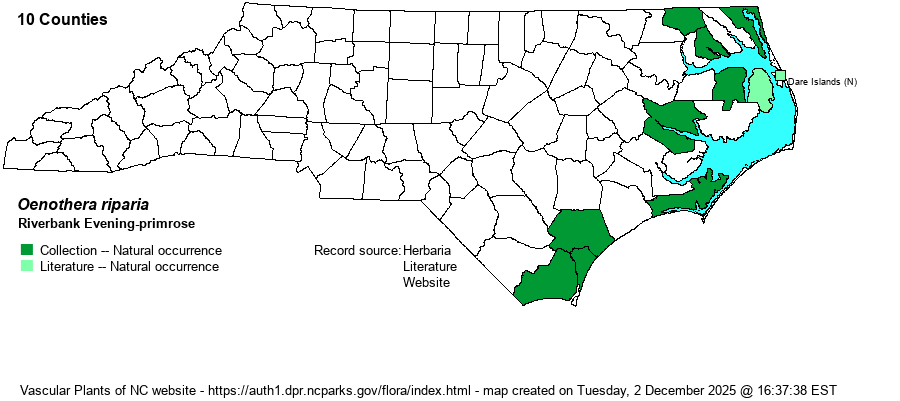| Author | Nuttall | |
| Distribution | Present in the lower Coastal Plain from the VA border to the SC border, mainly near the upper portions of embayed rivers. Ranges inland to Gates and Beaufort counties.
This species is limited to a small area along the Mid-Atlantic Coast, from southeastern VA south to eastern SC.
| |
| Abundance | Uncommon to locally common, but restricted to about 8-12 rivers. This is a State Special Concern species, and it has a Global Rank of G3, globally the rarest of the Oenothera species found in NC. | |
| Habitat | This is a species found only along the margins of tidal freshwater rivers and larger tidal streams, such as along marsh edges and edges of swamp forests. The species is most readily seen from canoes and kayaks. | |
| Phenology | Blooms from June to September, and fruits shortly after flowering. | |
| Identification | This is a tall and erect species, often growing to 3 feet tall or higher. It has traditionally been included within O. fruticosa, and has many features the same, but on a larger scale in this species. Plants are freely branched, somewhat pubescent overall. The alternate leaves are larger than on O. fruticosa, averaging about 3-4 inches long and about 2/5-inch wide; leaves of the common species are seldom more than about 2 inches long and 1/3-inch wide. This species typically has spongy lower stems and has adventitious roots where regularly submerged. Thus, this species grows essentially along tidal fresh waters, with its "feet" wet along the river edge, and has noticeably larger and longer leaves and a much taller overall height. Not surprisingly, the flowers are also larger, with each of the 4 bright golden yellow petals about 1-inch long or slightly less. With the rising sea levels and increase of salt and brackish waters pushing farther inland, the future of this species is uncertain. The species may simply move farther upriver than at present, but if this "farther upriver" area is upland and not currently wetland, the species may have trouble surviving. | |
| Taxonomic Comments | Most references do not consider this as a good species, but Weakley (2018), FNA (2021), and NatureServe do. This may be a case of "having first-hand experience" with it to realize that it is quite different, as opposed to not having seen it and saying it must be just an ecotype of O. fruticosa that grows in tidal wetlands.
| |
| Other Common Name(s) | Riverbank Sundrops | |
| State Rank | S2S3 | |
| Global Rank | G3 | |
| State Status | SR-L | |
| US Status | | |
| USACE-agcp | | |
| USACE-emp | | |

